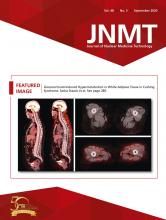RATIONALE/INTRODUCTION
Meckel’s diverticulum is a vestigial remnant of the omphalomesenteric duct (yolk stalk). It is usually 2 inches in length and located on the ileum about 2 feet from the end of the small intestine. Most people who have a Meckel’s diverticulum never have symptoms, but those who do are usually younger than 20 years of age, with the majority younger than 2 years of age. Most Meckel’s diverticula contain gastric mucosa, and the predominant symptom is lower intestinal bleeding from an ileal mucosal ulceration caused by acid secretion. Because 99mTc-pertechnetate avidly accumulates in gastric mucosa, this protocol is the study of choice for identifying ectopic gastric mucosa in a Meckel’s diverticulum.
INDICATIONS
Localization of a Meckel’s diverticulum with functioning gastric mucosa
Explanation of unexplained gastrointestinal bleeding
Evaluation of blood in feces
Evaluation of abdominal pain
Evaluation of bleeding, diverticulitis, or intestinal obstruction
CONTRAINDICATIONS
Pregnant/breast-feeding: Pregnancy must be excluded in accordance with local institutional policy. If the patient is breast-feeding, appropriate radiation safety instructions should be provided.
Active bleeding at the time of the study
Recent administration of potassium perchlorate; potassium perchlorate may be given after completion of the study
Cathartics or other bowel irritants within 24 h of examination
Barium study within 3 to 4 days of the study
Recent nuclear medicine study, especially studies with labeled red blood cells
PATIENT PREPARATION/EDUCATION
The patient should not eat or drink for 2 to 4 hours before the examination.
A focused history containing the following elements should be obtained:
History of past bleeding episodes
Results of prior studies to localize the bleeding site
Recent nuclear medicine study using in vivo red blood cell labeling
Clinical signs of active bleeding
PHARMACEUTICAL IDENTITY, DOSE, AND ROUTE OF ADMINISTRATION
See common options in the following text (Table 1).
Radiopharmaceutical Identity, Dose, and Route of Administration
ACQUISITION INSTRUCTIONS (TABLE 2)
Ask the patient to void before beginning the procedure.
Position the patient supine on the imaging table, with the detector positioned over the right lower quadrant of the abdomen.
Inject the dose intravenously and acquire a flow study at 1 second/frame for 1 minute.
Continue to acquire a dynamic study in the same position every minute for 30 to 60 minutes.
Obtain additional static images after dynamic images in the anterior oblique, lateral, and posterior projections.
Ask the patient to void and then acquire postvoid anterior, oblique, lateral, and posterior projections as necessary.
Images in the decubitus or upright position can aid in moving the Meckel’s diverticulum away from the bladder.
Acquisition Parameters: Dynamic/Static/Planar
COMMON OPTIONS
The patient may be pretreated with cimetidine (Tagamet) to enhance the sensitivity of the Meckel’s scan. The dose is 20 mg/kg orally starting 24 hours before the study and last taken 1 hour before the study.
The patient may be given potassium perchlorate orally after the scan (adult, 250 mg; child, 6 mg/kg) to facilitate the washout of 99mTc from the thyroid gland.
PROCESSING INSTRUCTIONS
Sum the dynamic images and display for optimal visualization of the area of interest.
Scale planar images to accurately visualize areas of normal anatomy and increased uptake.
ADJUNCT IMAGING/INTERVENTIONS
If the Meckel’s diverticulum is adjacent to the bladder and the patient is unable to void, a urinary catheter to drain the bladder of activity may be helpful.
PRECAUTIONS
None
Footnotes
↵* This book chapter was previously published in Quick-Reference Protocol Manual for Nuclear Medicine Technologists in 2014 (https://www.snmmi.org/Store/ProductDetail.aspx?ItemNumber=11002).







